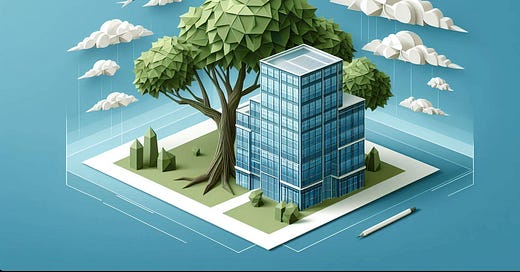The Plants Vs Buildings framework
This framework explores two alternative mindsets for developing capabilities and businesses - 'building' vs 'growing'
Business leaders discuss the need to 'build capabilities' – especially around new challenges like evolving into the digital world or entering complex new markets.
To 'build' capabilities, their mindset is often the same as constructing a building.
The first phase of the 'building' process is planning and designing. An architect creates a design according to the purpose and aesthetics needed. They then translate the design into a cost estimate and allocate resources. A civil engineer is found, and various contractors are engaged. Machinery is moved. Foundations are dug. Concrete is poured. Steel is embedded in the cement, so the building is strong and earthquake-proof. A manager is placed on the construction site to oversee progress against the detailed time and work schedule. Once in a while, the site owner comes to inspect progress. After a year or two, a shiny new building is in place.
By nature, building designs are rigid, and the designer must know precisely what to create before the workers make it – the process is not flexible mid-way if the needs change while the building is being constructed.
If you apply the building analogy to a complex new task like taking a legacy business into the digital world or entering a complex new market like China or India, this approach may have challenges.
For a complex task in a world changing at an accelerating rate, we may not know enough to create a rigid design that will be optimal when the building is entirely constructed. The builders of a flyover in Mumbai recently learned this lesson when the finished flyover ended up 6 feet away from where it was supposed to connect, leading to an embarrassing gap.
Leaders who build capabilities using this model run the risk of having the illusion of a 'perfect plan'. They may fully staff the project with competent managers and detailed KPIs/metrics, yet still fail because they may do things right, but not the right things!
Another approach, sometimes used by more 'local' companies and small, fast-moving companies in rapidly evolving technology areas, is more organic.
Rather than 'building' structures, treat capabilities like 'growing' plants.
In this approach, it is essential to choose the right seed. These need to be planted in fertile ground. Once planted, the seed needs sunshine, water, fertiliser and patience. As it turns into a small plant and grows further into a young tree, it needs protection from pests and correction while young if it is not growing straight. Eventually, it grows into a beautiful tree.
The plant is predictable in a broad sense (the type of tree depends on the kind of seed, and the growth depends on the conditions), but it is unpredictable in a narrow sense (it is impossible to predict each twig, leaf or root). Each tree may look different depending on how it evolves to best thrive in its environment. On the other hand, the building is predictable – it looks exactly like its designers planned.
The approach allows a single gardener to sow multiple seeds to reduce the risk of failure and cover more possible eventualities. As plants grow, they create additional seeds which evolve in Darwinian ways over generations to ensure the future growth of the species.
Both approaches require thoughtfulness at the start – but unlike the detailed, resource-constrained, KPI-driven building planner, the gardener needs to consider fewer details – just the seed and the conditions. It requires more patience and faith but fewer resources and no micromanagement.
Companies and managers may get locked into one of these two modes and are often convinced that their way is the 'best way'.
Using this framework:
There is room for both approaches – the 'build' approach should be used in stable, relatively slowly changing conditions where the designer is very sure of deliverables and the project's duration. The designer can use the 'grow' approach in fast-evolving situations or when the designer's knowledge is imperfect.
Companies need to decide whether they want gardeners or builders depending on the approach required for the role.
Both roles have different mindsets – putting a gardener mindset into a builder role can be very risky, and placing a builder mindset into a gardener role can be very frustrating. KPIs for builders need to be very time-bound, precise and input-driven. In contrast, gardeners need more holistic and output-driven KPIs with more relaxed time scales.
There is also an opportunity to combine both archetypes - In a glass house, a rigid structure gives protection and nourishment for plants to grow. When designing ‘intrapreneurial’ models, companies must ensure that their rigid structures leave access to enough light and nourishment for the ‘plants’ to grow.





The analogy works beautifully. It brings to the surface the false certainty we may be desperate for in developing businesses. A couple of thoughts it evokes:
1. A builder's feedback loop is much less noisier than the gardener's. It is much clearer what went wrong when building than when gardening because there are more unknowns and uncontrollables in the latter.
2. There's probably a profile that comes after builders. They are the multipliers. They take a proven formula and use it to quickly replicate the same building elsewhere. These are the ops people.
This was very insightful. Thank Addy. I have one suggestion, you can also record your video in which you explain your framework with example, its just 2-3 minutes video.
Shubham, Your fellow reader!!!